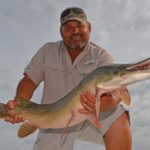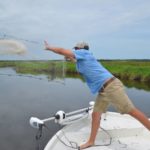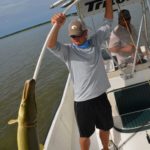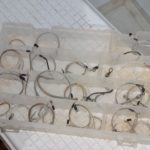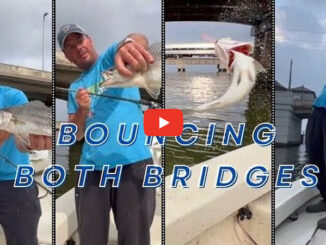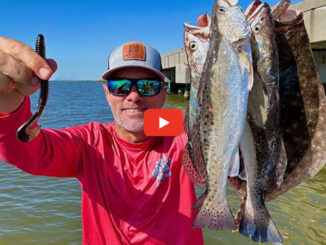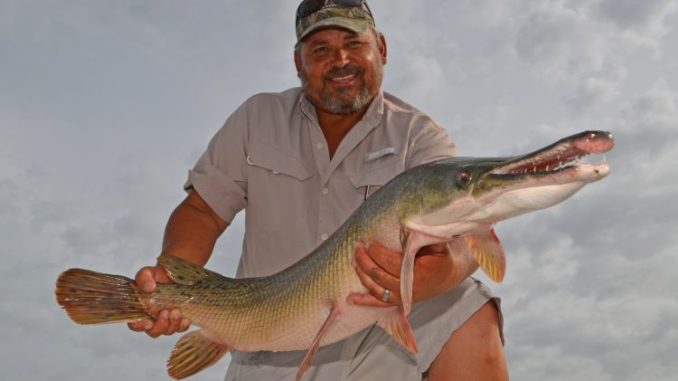
While many anglers release sharks and gar, this Lake Pontchartrain guide actually targets the teeth. The fight is a blast — and the meat haul is even better.
The kraken (pronounced KROK-in) is a legendary giant sea monster said to dwell off the coasts of Norway and Greenland.
The business card on the counter of Bayou Adventure in Lacombe couldn’t help but catch my eye. An orange-skeletoned alligator gar with a gaping mouth full of fangs slithered sinuously down the black card’s face.
It read, “Wicked Fishing Charters. Huntin’ the Kraken, 985-750-0670.”
OK; I bit.
The friendly voice on the other end of the phone belonged to Andy Jones, a retired U.S. Coast Guardsman and now full time charter guide specializing in Lake Pontchartrain fishing.
“Yeah, we catch a lot of alligator gar. In fact, May is the start of the best time for gar and shark fishing.”
“Sharks? Sharks?” I questioned.
“Oh yeah,” he replied matter-of-factly. “Pretty good ones too; right here next to New Orleans.”
Jones, it turned out, spends much of the year like other Lake Pontchartrain fishermen — hammering speckled trout in early spring and all fall at the lake’s bridges and chasing redfish much of the rest of the time.
But from May through September, he spends an increasing amount of his effort chartering for gar and sharks. The idea for fishing for toothy fish came during a father-son charter trip.
“They had a limit of slot reds and a couple of big bull redfish too. They also caught a shark and a gar. All they talked about at the dock were the gar and the shark.
“Many fishermen release their catch of gar and sharks, because they fish for the thrill of catching them. But a surprising number of them keep their gar.”
Ducking between days of squalls and blow-ups, I finally met the man at the Mandeville Boat Launch, at the mouth of Bayou Castine. He looked like a sailor, stocky and heavily suntanned, with a mariner’s short-cropped beard.
With him were his two sons and sometimes deckhands, 16-year-old Hunter, a high school student, and 21-year-old Tyler, a warehouse associate for a wholesale pool supply company and a fishing addict.
Once out of the launch harbor and into Lake Pontchartrain proper, Capt. Andy turned his boat east for the run to his favorite fishing grounds for this kind of fishing: The numerous bayous that empty into the lake on its northern shore.
Predators of opportunity
His choice of anchoring spots in bayous was always where they could cast to a spot where the bayou makes a sharp bend. Garfish, he said, set up off points in bends as ambush spots.
“Most of the time, garfish are not active ambush predators,” said Tyler. “They are predators of opportunity.
“Sometimes they will actively run down baitfish, but often they just take whatever comes.”
They set two lines out of one end of the boat, and one line out of the other. Two were Texas rigs, and one was free-lined. The free-line rig always had a live mullet on it.
The trio fished three different spots in the bayou, with the same results — no bites. Jones picked up his Power-Poles and moved the boat down the bayou into 4 ½ feet of water, and anchored where the bottom dropped off from the lake’s shoreline flats.
“There is no dependable pattern on whether to fish the bayous or the lake for gar,” he noted. “They do seem to swim more actively in the lake though. Some people think gar are lazy fish, but I just think they are opportunistic.”
The gentle but steady breeze in the open lake was welcome after the smothering heat of the marsh. Again, out went three rods — but it didn’t take long this time.
Inside of five minutes, they boated an impressive — but not quite 54-inch — bull shark. Then bedlam broke loose. The lines on all three reels began to sizzle in three different directions.
One fish dropped the bait, but they wrestled the other two in, both bull sharks, one of which was more than 5 feet long.
One more shark came in over the rail and after that is was all garfish; seemingly one after the other. Some were bigger than others, but they were all over 4 feet long.
Then a moment of quiet.
Dark blue squall clouds were threatening from the south and the men were debating pulling up, when another line zinged.
This one was the lone bull red of the day, a catch that delighted Jones.
“Now we have our Wicked Fishing Charter Grand Slam,” he beamed broadly.
Landing the beasts
Most fishermen want to land their catch, whether for a photo opportunity or — especially in the case of alligator gar — to keep for the dinner table.
Gaffing a shark, which will likely be released, is not a good option. It’s impossible for alligator gar, whose entire body in encased in overlapping scales constructed of thick bone. Landing gar by hand is out of the question, as well. Their bodies are covered in ultra-slime and their near-razor sharp gill covers will inflict a severe cut to the hand every time.
A BogaGrip or similar device will work for redfish, but not for the toothy mouths of sharks and gar. Sharks can be dangerous to land, when one can quickly twist out of a grip and inflict a mean bite on its tormenter.
Andy Jones relies on a turbo-sized landing net to land redfish and trout — simple enough.
But gar, with their extremely long and rigid bodies, are a different story. He solved the dilemma by inventing what can only be called a noose on a stick, similar to the animal-control tool commonly used by dog catchers.
He threads a poly rope through a 6-foot length of PVC pipe and ties it to a hole he has pre-drilled near its end. (The rope should be a little longer than twice the length of pipe.)
The device is used by pulling enough rope out of its business end to make a sizeable loop. After the fish is subdued, the loop is slipped over the rod and reel beginning at the butt of the rod.
It’s worked down the length of the rod and the line and ultimately over the fish’s head. When the loop is positioned behind the head and pectoral (side) fins, it is tightened securely by pulling rope back through the pipe.
The entire fish may then be swung into the boat.
Dragon slayers’ swords
The Jones’ used surprisingly unsophisticated tools to bring the lake’s toothy dragons to heel, starting with their reels.
They were Penn Battle 2000 spinning reels, priced at about $100. “They hold up to these big fish pretty good,” explained the charter captain. The rods were a mixture of brands in medium to medium-heavy weights.
The reels were spooled with 30-pound PowerPro braid tipped with 3- to 4-foot, 50-pound Malon-7 nylon-coated braided wire leaders. A 5/0 to 8/0 Mustad or Gamakatsu hook is crimped to one end of the leader.
A swivel is crimped on the other end. Before the braid is tied to the swivel, a ¾- to 1-ounce barrel sinker is threaded on the line for those to be fished as Texas rigs.
The heavy weights and large hooks seem to be overkill for the medium-weight rods, but Jones growled that he would rather use this equipment than heavy stuff (“broomsticks,” he called them) to get the maximum action from each fish.
Feeling the bite — and getting the fight
Bites from two of the three big fish they target are relatively straightforward. Redfish and bull sharks bite hard and fight doggedly. Sharks can be likened to swimming sledge hammers.
But alligator gar do different things. Sometimes a gar just mouths the bait; sometimes it slowly swims off — feeling to the angler like being hooked to the rear of a slow-moving Volkswagen. And sometimes, they tear off in a screaming run, resembling that of a big bull red.
“A dead give-away,” said Tyler Jones, “is that once they are hooked, they usually either run straight away from you or straight toward you. They seldom run sideways. And you will feel a lot of head shakes.”
“During the fight,” added brother Hunter, “you can feel the weight of their whole body move.”
A lot of how they behave depends on where they are hooked, added Tyler.
“If they swallowed the bait, they rely more on their weight during the fight,” he said. “If they are hooked in the mouth, they are much more active. Sometimes they actually tail-walk.”
“Alligator gar over 4 feet long will jump cleanly out of the water,” said Andy in affirmation to his son’s statement.
When a garfish mouths the bait, they coached, it is important to let the fish eat it. The bail of the reel should be opened, and the fisherman should hold the line between his forefinger and thumb as the fish takes line.
“When to close the bait and set the hook is a judgement call,” chuckled Andy.
“Setting the hook too early rips the hook right out of their mouths. It seems to be worse with live bait.”
“I think that they hold the live bait crossways in their mouths and cruise around with it before swallowing it,” added Taylor.
“They seem to swallow cut bait quicker.”
